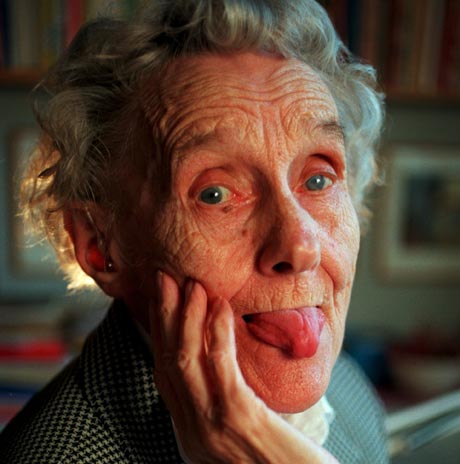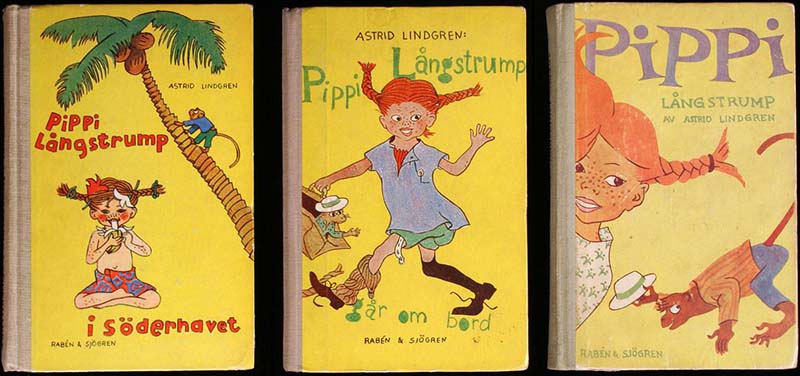Share via:
Astrid Lindgren – Swedish author, 1907-2002

Swedish author, 1907-2002. Best known for her books about the irrepressible heroine Pippi Longstocking, internationally acclaimed author Astrid Lindgren was bom in Vimmerby, Sweden, and grew up on a farm just outside of the village. She was one of four children and describes her own childhood as being much like those depicted in her Noisy Village books.
She and her siblings were allowed many freedoms and spent a great deal of time at play, although they were also expected to help with work on the farm. Lindgren read a great deal as a child but declared, when a teacher suggested she might become a writer when she grew up, that she would never write books.
After finishing school, Lindgren worked as a secretary had children of her own. Pippi Longstocking (1950) out of the stories she told her own daughter. She decided to write down the stories as a gift to her daughter and sent the completed manuscript to a publisher. The story was rejected, but the following year Lindgren submitted Pippi Longstocking to a contest at another Swedish publishing house and won first prize.
Pippi Longstocking became an international success and led to Lindgren’s long and prolific career writing well over one hundred books for children, more than half of which have been translated into English. Astrid Lindgren won the Hans Christian Andersen Medal in 1958, presented by the International Board on Books for Young People (IBBY) for her outstanding contribution to the field of children’s literature.
Lindgren’s many books include mysteries, fantasies, adventures, and realistic stories of family life in Sweden. She writes both picture books and novels, and her work appeals to children from preschool through elementary school. Pippi, the heroine of Pippi Longstocking, Pippi Goes on Board (1957), and Pippi in the South Seas (1959), lives without parents in the middle of a small town in Sweden.
Pippi is amazingly strong, able to pick up her own horse, and leads the life die chooses. She refuses to go to school until she hears about vacations and “pluttification” but quickly decides that the rules and structure are not for her. She is an outrageous heroine, anarchic and clever, continually inventing ways to amuse her more traditional friends Tommy and Annika. Pippi Longstocking is a perfect fantasy, a way for readers to revel in the possibilities of life without parents but with an endless supply of time and gold coins.

Astrid Lindgren firmly grounds her story in reality through the characters Tommy and Annika, children who, like her readers, must go to school and observe strict bedtimes but who can also enjoy the larks invented by their neighbor Pippi Longstocking.
Lindgren wrote many books based on her own childhood in a safe, warm Swedish village. The Children of Noisy Village (1962) and The Children on Troublemaker Street (1964) are two such novels. Each consists of episodic chapters that tell of the small adventures in the lives of children nurtured by close families and communities. Her characters go on picnics, invent games, and celebrate traditional Swedish holidays. Unlike the larger-than-life Pippi stories, these are tales of the excitement that everyday life can hold for children.
Bill Bergson, Master Detective (1952) and the subsequent adventures of Bill Bergson bridge the distance between Lindgren’s impossible fantasies and her concrete family stories. Bill and his friends live in a typical Swedish village and play games much like their counterparts in Noisy Village, but Bill hopes to be a detective and finds himself solving crimes and becoming involved with bandits and thieves. The satisfying mysteries appeal to the reader’s sense of adventure while remaining firmly planted in reality.
Rasmus and the Vagabond (1960) is another mystery complete with thieves, stolen jewels, and a chase through an abandoned town, but it is also the story of an orphan, Rasmus, who runs away from an orphanage to find himself a family. Rasmus discovers a gentle, loving vagabond, and the two tramp through the summer countryside singing and working for sandwiches. Again Lindgren convinces hef readers that a child who goes looking for parents will certainly find them.
Lindgren recognizes the central, yet conflicting longings of childhood—to have the security of a loving family but also a measure of adventure and excitement. In Brothers Lionheart (1973), two brothers die young but continue to have heroic adventures together in Nangilyala, an imaginary country invented by the author. Lindgren hopes that, while the book may disturb some adults, it will comfort young children wondering about death.
Astrid Lindgren recognizes and writes about the needs, dreams, and fantasies of children. Her characters, always strong and well defined, are remembered long after readers finish each book. She cites Lucy Maud Montgomery as a powerful literary influence. Her range is tremendous, from the quiet, mysterious picture book The Tomten (1961) to the hilarious, exaggerated adventures of Emil in Emil in the Soup Tureen (1963). Lindgren’s vivid writing and imaginative stories achieve a timeless quality that will ensure them an appreciative audience for many years to come.
Maeve Visser Knoth
Source: Children’s Books and their Creators, Anita Silvey.
Astrid Lindgren Works
Bill Bergson series (Mästerdetektiven Blomkvist)
- Bill Bergson, Master Detective (Mästerdetektiven Blomkvist, 1946)
- Bill Bergson Lives Dangerously (Mästerdetektiven Blomkvist lever farligt, 1951)
- Bill Bergson and the White Rose Rescue (Kalle Blomkvist och Rasmus, 1954)
Children’s Everywhere series
- Noriko-San: girl of Japan (also known as: Eva Visits Noriko-San, Swedish: Eva möter Noriko-san, 1956)
- Sia Lives on Kilimanjaro (Sia bor på Kilimandjaro, 1958)
- My Swedish Cousins (Mina svenska kusiner, 1959)
- Lilibet, circus child (Lilibet, cirkusbarn, 1960)
- Marko Lives in Yugoslavia (Marko bor i Jugoslavien, 1962)
- Dirk Lives in Holland (Jackie bor i Holland, 1963)
- Randi Lives in Norway (also known as: Gerda Lives in Norway, Swedish: Randi bor i Norge 1965)
- Noy Lives in Thailand (Noy bor i Thailand, 1966)
- Matti Lives in Finland (Matti bor i Finland, 1968)
The Children on Troublemaker Street series
- The Children on Troublemaker Street (also known as: Lotta, Lotta Says No!, Mischievous Martens, Swedish: Barnen på Bråkmakargatan, 1956)
- Lotta on Troublemaker Street (also known as: Lotta Leaves Home, Lotta Makes a Mess, Swedish: Lotta på Bråkmakargatan, 1961)
- Lotta’s Bike (also known as: Of Course Polly Can Ride a Bike, Swedish: Visst kan Lotta cykla, 1971)
- Lotta’s Christmas Surprise (also known as: Of Course Polly Can Do Almost Anything, Swedish: Visst kan Lotta nästan allting, 1965
- Lotta’s Easter Surprise (Visst är Lotta en glad unge, 1990)
Emil of Lönneberga series (Emil i Lönneberga)
- Emil in the Soup Tureen (also known as: Emil and the Great Escape, That Boy Emil!, Swedish: Emil i Lönneberga, 1963)
- Emil’s Pranks (also known as: Emil and the Sneaky Rat, Emil Gets into Mischief, Swedish: Nya hyss av Emil i Lönneberga, 1966)
- Emil and Piggy Beast (also known as: Emil and His Clever Pig, Swedish: Än lever Emil i Lönneberga, 1970)
- Emil’s Little Sister (also known as: När lilla Ida skulle göra hyss, 1984)
- Emil’s Sticky Problem (also known as: Emils hyss nr 325, 1970)
Karlsson-on-the-Roof series (Karlsson på taket)
- Karlsson-on-the-Roof (also known as: Karlson on the Roof, Swedish: Lillebror och Karlsson på taket, 1955)
- Karlson Flies Again (also known as: Karlsson-on-the-Roof is Sneaking Around Again, Swedish Karlsson på taket flyger igen, 1962)
- The World’s Best Karlson (Karlsson på taket smyger igen, 1968)
Kati series
- Kati in America (Kati i Amerika, 1951)
- Kati in Italy (Kati på Kaptensgatan, 1952)
- Kati in Paris (Kati i Paris, 1953)
Madicken series
- Mardie (also known as: Mischievous Meg, Swedish Madicken, 1960)
- Mardie to the Rescue (Madicken och Junibackens Pims, 1976)
- The Runaway Sleigh Ride (Titta, Madicken, det snöar!, 1983)
Peter & Lena series
- I Want a Brother or Sister (also known as: That’s My Baby, Swedish: Jag vill också ha ett syskon, 1971)
- I Want to Go to School Too (Jag vill också gå i skolan, 1971)
Pippi Longstocking series (Pippi Långstrump)
- Pippi Longstocking (Pippi Långstrump, 1945)
- Pippi Goes On Board (also known as: Pippi Goes Aboard, Swedish: Pippi Långstrump går ombord, 1946)
- Pippi in the South Seas (Pippi Långstrump i Söderhavet, 1948)
- Pippi’s After-Christmas Party (Pippi Långstrump har julgransplundring, 1950)
- Pippi Longstocking in the Park (Pippi Långstrump i Humlegården, 1945)
- Pippi Moves In! (Pippi flyttar in, 1969)
The Six Bullerby Children / The Children of Noisy Village series (Barnen i Bullerbyn)
- The Children of Noisy Village (also known as: Cherry Time at Bullerby, Swedish: Alla vi barn i Bullerbyn , 1947)
- Happy Times in Noisy Village (Bara roligt i Bullerbyn, 1952)
- Christmas in Noisy Village (Jul i Bullerbyn, 1963)
- Springtime in Noisy Village (Vår i Bullerbyn’, 1965)
- Children’s Day in Bullerbu (also known as: A Day at Bullerby, 1967)
The Tomten series
- The Tomten (Tomte är vaken, 1960)
- The Tomten and the Fox (Räven och Tomten, 1966)
Individual books
- The Brothers Lionheart (Bröderna Lejonhjärta, 1973)
- Brenda Brave Helps Grandmother (Kajsa Kavat hjälper mormor, 1958)
- A Calf for Christmas (När Bäckhultarn for till stan, 1989)
- Christmas in the Stable (Jul i stallet, 1961)
- The Day Adam Got Mad (also known as: Goran’s Great Escape, The Day Adam Got Angry, Swedish: När Adam Engelbrekt blev tvärarg, 1991)
- The Dragon with Red Eyes (Draken med de röda ögonen, 1985)
- The Ghost of Skinny Jack (Skinn Skerping – Hemskast av alla spöken i Småland, 1986)
- How Astrid Lindgren achieved enactment of the 1988 law protecting farm animals in Sweden (Min ko vill ha roligt, 1990)
- I Don’t Want to Go to Bed (Jag vill inte gå och lägga mig!, 1947)
- In the Land of Twilight (I Skymningslandet, 1994)
- Mio, My Son (also known as: Mio, My Mio, Swedish: Mio, min Mio, 1954)
- Mirabelle (Mirabell, 2002)
- Most Beloved Sister (also known as: My Very Own Sister, Swedish: Allrakäraste syster, 1973)
- My Nightingale Is Singing (Spelar min lind, sjunger min näktergal, 1959)
- Never Violence (Aldrig våld, 2018)
- Rasmus and the Vagabond (also known as: Rasmus and the Tramp, Swedish: Rasmus på luffen, 1956)
- Ronia the Robber’s Daughter (Ronja rövardotter, 1981)
- The Red Bird (Sunnanäng, 1959)
- Scrap and the Pirates (also known as: Skrallan and the Pirates, Swedish: Skrållan och Sjörövarna, 1967)
- Simon Small Moves In (Nils Karlsson-Pyssling flyttar in, 1956)
- Samuel August from Sevedstorp and Hanna i Hult (also known as A love story, Swedish: Samuel August från Sevedstorp och Hanna i Hult, 1975)
- Seacrow Island (Vi på Saltkråkan, 1964)
- War Diaries, 1939-1945 (Krigsdagböcker 1939–1946, 2015)
